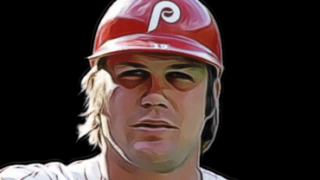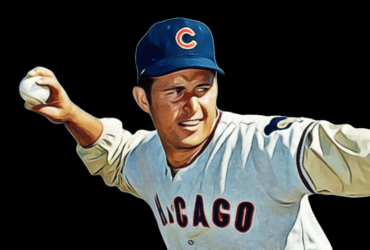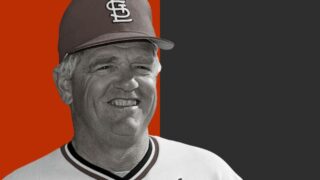After battling his entire life against incredible odds, Ron Santo died on Thursday, December 2. An All-Star third baseman for the Chicago Cubs, Santo thrilled fans with his home run power and exuberant emotion on the diamond. In 1969, the season that the Cubs came the closest to winning a post-season birth, he was known for jumping in the air and clicking his heels after a Cub win.
Santo played his entire big league career with diabetes, even keeping the disease from the Cubs in fear that it would jeopardize his roster spot with the club. But there was never any doubt about Santo’s place in uniform. He was the greatest third baseman in franchise history. Santo hit 342 career home runs and won five Gold Gloves. Playing all but one season with the Cubs, Santo never made it to the post-season. He hit 30 homers and batted .300 four times each, despite playing much of his career in an era where pitching ruled the game. He paced the National League in walks four times. He topped NL third basemen in putouts seven times, assists seven times, and double plays four times. He was the best third baseman in the National League in the 1960s and challenged Brooks Robinson for the honor as best hot corner man in the entire game.
After his playing career, Santo suffered numerous health problems: heart attacks, bypass surgery, amputation of his legs, and a battle with cancer that ultimately claimed his life. Throughout it all, Santo remained a positive man who delighted Chicago fans with his love for the National Pastime. He was unquestionably the greatest Cubs’ third baseman, and he rates high among the Top 100 Third Basemen in Baseball History.
Baseball Writers Snubbed Santo
In one of the the worst cases of Hall of Fame snubbing in the history of that wonderful organization, Santo failed to earn induction despite his obvious qualifications. It was puzzling to many who saw him in his prime. His detractors, whom apparently numbered enough to keep the Baseball Writers and Hall of Fame Veterans Committee from electing him, claimed his career was too short to have reached major statistical milestones, he never played on a winner, or that his career batting average was too unimpressive.
But Santo’s numbers stack up well against third basemen already enshrined in the Hall of Fame. His career OPS+, which is on-base percentage plus slugging adjusted for the era and ballparks played in, is 125. There are 11 players in the HOF categorized as third basemen, not counting Negro Leaguers. Santo’s OPS+ is better than six of them: Paul Molitor (122), Jimmy Collins (113), George Kell (111), Freddie Lindstrom (110), Pie Traynor (107), and Brooks Robinson (104). But Molitor, Collins, Kell, Lindstrom, and Traynor all hit for a .300 average for their careers, something HOF voters obviously value over power and the ability to get on base. If voters dug deeper, they would learn that adjusted for his era, Santo’s career batting average is comparable to those of Kell, Collins, and Traynor.
Santo’s WAR is 66.4 for his career. Compared to HOF third basemen, that ranks only below Mike Schmidt, Eddie Mathews, Wade Boggs, George Brett, Paul Molitor, and Brooks Robinson. WAR rates Robinson at 69.1, boosting him just above Santo based on his defense. But Santo rates higher than HOFers Frank Baker, Collins, Traynor, Kell, and Lindstrom. Santo’s 342 homers rank behind only Schmidt and Mathews. Santo drove in more runs than all but four Hall of Fame third sackers.
One of Baseball’s Most Productive Players in the 1960s
Santo’s first regular season was 1961, and for the next 13 years he was one of his league’s most productive players regardless of position. During the 1960s only two players drove in more runs than Santo in the National League: Hank Aaron and Willie Mays. His Wins Above Replacement total for the decade trailed only Mays, Aaron, and Roberto Clemente.
Left fielder Billy Williams, who like Santo was in his prime during the 1960s, was his teammate on the Cubs. For the decade, Williams hit fewer homers and drove in fewer runs than Santo, and his OPS of .850 was just slightly better than Santo’s mark of .844. Yet Williams is in the Hall of Fame, Santo is not.
Yet another stat called Batting Runs, developed by famed sabermetrician Bill James, makes the Hall of Fame case even stronger for Santo. For the 1960s, Santo’s total of 254 batting runs (a measure of his overall offensive production) ranks 12th in all of baseball. It’s a total that’s higher than that of Williams, Orlando Cepeda, and Willie Stargell, other sluggers who are in Cooperstown and played their primes during that decade. According to James, Brooks Robinson accumulated 112 batting runs in the 60s. The question: do Santo’s extra 142 batting runs make up for the gap between his defensive play and that of Robinson? Santo may not have the dazzling defensive stats Robinson put up, but he still won five Gold Gloves for his work around the bag at third.
Looking at the overall pool of third basemen in baseball history, there have been 102 players who have played as many as 1,200 games in the majors with at least half coming at the hot corner. When you rank those 102 players by just about any statistical method, Santo is always in the top 10. In OPS+ he is seventh, trailing Schmidt, Mathews, Chipper Jones, Brett, Baker, and Boggs. In homers, RBI, walks, slugging and on-base percentage, Santo rates in the top ten. If the Hall of Fame is supposed to honor the best players, it can be presumed that one of the top ten third basemen in history (by several measures) deserves to be enshrined.
Santo doesn’t belong with the upper crust of Hall of Fame third basemen: Schmidt, Mathews, Brett, and Boggs. But he certainly compares well to the next group: Molitor, Robinson, and Baker. And when compared to the rest of the third basemen in the Hall (Collins, Kell, Lindstrom, Traynor), Santo is markedly superior. His day in Cooperstown never came while he was alive, but he deserves to be honored posthumously, and it’s long overdue.




